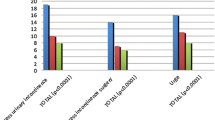Abstract
Introduction and hypothesis
The quality of information related to pelvic floor disorders is varied and understudied. Using a validated instrument we evaluated the quality of selected websites addressing treatment options for pelvic organ prolapse (POP) and stress urinary incontinence (SUI).
Methods
English-language, patient-focused professional, governmental, and consumer websites related to POP and SUI were identified using the International Urogynecology Association (IUGA) list of continence societies worldwide, search terms, and provider nomination. Websites were evaluated by 10 providers at an academic medical center, representing urogynecology (6), urology (3), and general gynecology (1). Quality assessment utilized the DISCERN instrument, a validated instrument consisting of 16 questions addressing the quality of consumer health information.
Results
Websites of 13 organizations met inclusion criteria and were assessed, 12 relating to SUI and 8 to POP. The websites with the highest mean total DISCERN score for POP were those of the IUGA, the American Society of Colon and Rectal Surgeons, and the American Urogynecologic Association, and for SUI, the National Association For Continence, the American Urological Association, and the IUGA. High correlations were obtained for the total DISCERN score and the overall quality scores for POP (0.76) and SUI (0.82). The most commonly omitted components of the DISCERN instrument were a clear statement of the content objectives, references or sources of the content, and a discussion of what patients could expect if they opted for no intervention.
Conclusions
Available English-language professional websites written to inform patients about management choices for SUI and POP miss key components of quality patient information.


Similar content being viewed by others
References
Aldairy T, Laverick S, McIntyre GT (2012) Orthognathic surgery: is patient information on the internet valid? Eur J Orthod 34:466–469
Shuyler KS, Knight KM (2003) What are patients seeking when they turn to the internet? Qualitative content analysis of questions asked by visitors to an orthopaedics web site. J Med Internet Res 5:e24
Sajadi KP, Goldman HB, Firoozi F (2011) Assessing internet health information on female pelvic floor disorders. J Urol 186:594–596
Charnock D, Shepperd S, Needham G, Gann R (1999) DISCERN: an instrument for judging the quality of written consumer health information on treatment choices. J Epidemiol Community Health 53:105–111
O’Neill SC, Baker JF, Fitzgerald C, Fleming C, Rowan F, Byrne D et al (2014) Cauda equina syndrome: assessing the readability and quality of patient information on the internet. Spine (Phila Pa 1976) 39:E645–E649
McKearney TC, McKearney RM (2013) The quality and accuracy of internet information on the subject of ear tubes. Int J Pediatr Otorhinolaryngol 77:894–897
Grohol JM, Slimowicz J, Granda R (2014) The quality of mental health information commonly searched for on the internet. Cyberpsychol Behav Soc Netw 17:216–221
Goslin RA, Elhassan HA (2013) Evaluating internet health resources in ear, nose, and throat surgery. Laryngoscope 123:1626–1631
Ting K, Hu A (2013) Evaluating the quality and readability of thyroplasty information on the internet. J Voice 3:378–381
Ghobrial GM, Mehdi A, Maltenfort M, Sharan AD, Harrop JS (2014) Variability of patient spine education by Internet search engine. Clin Neurol Neurosurg 118:59–64
Batchelor JM, Ohya Y (2009) Use of the DISCERN instrument by patients and health professionals to assess information resources on treatments for asthma and atopic dermatitis. Allergol Int 58:141–145
Koch GG (1982) Intraclass correlation coefficient. In: Kotz S, Johnson NL (eds) Encyclopedia of statistical sciences. Wiley, New York, pp 213–217
Winker MA, Herron M, Jones E, Bauchner H (2012) The JAMA network website: today’s content on the future of medical publishing. JAMA 307:2321
Gagliardi A, Jadad AR (2002) Examination of instruments used to rate quality of health information on the internet: chronicle of a voyage with an unclear destination. BMJ 324:569–573
Jadad AR, Gagliardi A (1998) Rating health information on the internet: navigating to knowledge or to Babel? JAMA 279:611–614
Boyer C, Selby M, Scherrer JR, Appel RD (1998) The health on the net code of conduct for medical and health websites. Comput Biol Med 28:603–610
Winker MA, Flanagin A, Chi-Lum B, White J, Andrews K, Kennett RL et al (2000) Guidelines for medical and health information sites on the internet: principles governing AMA web sites. American Medical Association. JAMA 283:1600–1606
Acknowledgements
Katherine Leung MPH for her valuable assistance in the statistical analysis of this project.
Conflicts of interest
None.
Author information
Authors and Affiliations
Corresponding author
Rights and permissions
About this article
Cite this article
Dueñas-Garcia, O.F., Kandadai, P., Flynn, M.K. et al. Patient-focused websites related to stress urinary incontinence and pelvic organ prolapse: a DISCERN quality analysis. Int Urogynecol J 26, 875–880 (2015). https://doi.org/10.1007/s00192-014-2615-3
Received:
Accepted:
Published:
Issue Date:
DOI: https://doi.org/10.1007/s00192-014-2615-3




